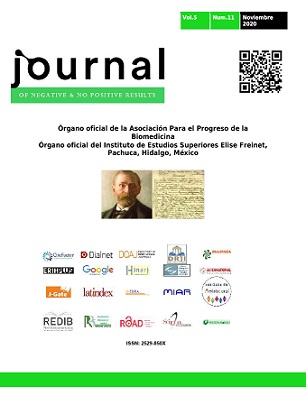Phylogeography of glmM in Helicobacter pylori strains isolated from patients with gastric pathologies in southern Mexico
DOI:
https://doi.org/10.19230/jonnpr.3769Keywords:
Helicobacter pylori, genetic variability, glmM gene, phylogeographyAbstract
Introduction: Helicobacter pylori has a genome of approximately 1600 genes, the glmM gene is highly conserved and has been identified to identify H. pylori due to its sensitivity and specificity in gastric biopsies. The genetic diversity of H. pylori is high among strains of the same geographical origin and is even more of a global scale. In Mexico, studies that study the importance of the genetic variability of this bacterium, which is studied by molecular techniques.
Aim. To analyze the genetic variability of the glmM genus in H pylori strains of patients with gastric pathologies.
Methodology. Only 90 sequences of the glmM genus were analyzed (10 of study group and 80 deposit in GenBank), to carry out haplotype networks, where the differences in the steps of the relationships at the state level and with other geographical groups can be observed in order to do a reconstruction of phylogeny based on ancestor-descendant relationships.
Results. The strains analyzed showed 30% of men and 70% of women, with an average age of 42 years, diagnosed with gastritis, the glmM sequences. From the sequences analyzed, it is proposed to confirm the presence of eight haplotypes that are grouped separately.
Conclusions. We suggest university studies at the molecular level of the glmM haplotypes in strains of H. pylori to know their geographical distribution in order to know the circulating strains worldwide and with this avoid negative results.
Downloads
References
Hunt, R.H., Xiao, S.D., Megraud, F., Leon-Barua, R., Bazzoli, F., van der Merwe., et al. Helicobacter pylori en los países en desarrollo. Guías prácticas de la Organización Mundial de Gastroenterología. 2010. 1: 3-10. https://www.worldgastroenterology.org/UserFiles/file/guidelines/helicobacter-pylori-spanish-2010.pdf
Mobley, H., Mendz, G., Hazell, S. Heterogenity and Subtyping. Helicobacter pylori: Physiology and Genetics. 2001. 3:15-20. https://www.ncbi.nlm.nih.gov/books/NBK2436/
Suzuki, R., Shiota, S., Yamaoka, Y. Molecular epidemiology, population genetics, and pathogenic role of Helicobacter pylori. Infection, Genetics and Evolution. 2002. 12:203-13. doi: 10.1016/j.meegid.2011.12.002.
Espinoza, M. G., Vazquez, R. G., Mendez, I. M., Vargas, C. R., & Cerezo, S. G. Detection of the glmM gene in Helicobacter pylori isolates with a novel primer by PCR. Journal of Clinical Microbiology. 2011. 49(4), 1650–2. doi:10.1128/JCM.00461-10
Tamer, E., Wail, H., Israr, S., Walid, S., Mohammad, F. Determination of Helicobacter pylori Virulence Genes in Gastric Biopsies by PCR. ISRN Gastroenterology. 2003. 13:4. doi: 10.1155/2013/606258
Dorer, M. S., Fero, J., Salama, N. R., (2010) DNA damage triggers genetic exchange in Helicobacter pylori. PLoS Pathogens. 6: 1–10. doi: 10.1371/journal.ppat.1001026
Goosen C, Theron J, Ntsala M, Maree FF, Olckers A, Botha SJ, Lastovica AJ, van der Merwe SW. Evaluation of a novel heminested PCR assay based on the phosphoglucosamine mutase gene for detection of Helicobacter pylori in saliva and dental plaque. J Clin Microbiol. 2002 Jan;40(1):205-9. doi: 10.1128/jcm.40.1.205-209.2002. PubMed PMID: 11773117; PubMed Central PMCID: PMC120087.
Florez Rueda Ana Marcela. Estructura poblacional y filogeografia de Curcubita moschata. Tesis de Maestría, Universidad Nacional de Colombia. 2009. http://bdigital.unal.edu.co/1873/
Avise, J.C. Phylogeography: the history and formation of species. Cambridge, Massachusetts Harvard University, Massachusetts, 1999. 417 pp. DOI: 10.1093/icb/41.1.134
Gressmann, H., Linz, B., Ghai, R., Pleissner, K.P., Schlapbach, R., Yamaoka, Y., Kraft, C., et al. Gain and Loss of Multiple Genes During the Evolution of Helicobacter pylori. PLoS Genet. 2005. 1: 424-6. DOI:10.1371/journal.pgen.0010043
Janssen, P.J., Audit, B., Ouzounis, C.A. Strain-specific genes of Helicobacter pylori: distribution, function and dynamics. Nucleic Acids Res. 2001. 1: 4395–404. DOI: 10.1093/nar/29.21.4395
Dong, Q.J., Wang, Q., Xin, Y.N., Li, N., Xuan, S.Y. Comparative genomics of Helicobacter pylori. World J Gastroenterol. 2009. 15: 3984-91. doi: 10.3748/wjg.15.3984
Odenbreit, S., Swoboda, K., Barwig, I., Ruhl, S., Borén, T., Koletzko, S. Outer Membrane Protein Expression Profile in Helicobacter pylori Clinical Isolates. Infect Immun. 2009. 77: 3782–90. doi: 10.1128/IAI.00364-09.
Published
Issue
Section
License
All accepted originals remain the property of JONNPR. In the event of publication, the authors exclusively transfer their rights of reproduction, distribution, translation and public communication (by any sound, audiovisual or electronic medium or format) of their work. To do so, the authors shall sign a letter transferring these rights when sending the paper via the online manuscript management system.
The articles published in the journal are freely used under the terms of the Creative Commons BY NC SA license, therefore.
You are free to:
Share — copy and redistribute the material in any medium or format
Adapt — remix, transform, and build upon the material
The licensor cannot revoke these freedoms as long as you follow the license terms.
Under the following terms:
Attribution — You must give appropriate credit, provide a link to the license, and indicate if changes were made. You may do so in any reasonable manner, but not in any way that suggests the licensor endorses you or your use.
NonCommercial — You may not use the material for commercial purposes.
ShareAlike — If you remix, transform, or build upon the material, you must distribute your contributions under the same license as the original.
No additional restrictions — You may not apply legal terms or technological measures that legally restrict others from doing anything the license permits.

This work is licensed under a Creative Commons Attribution-NonCommercial-ShareAlike 4.0 International License

























